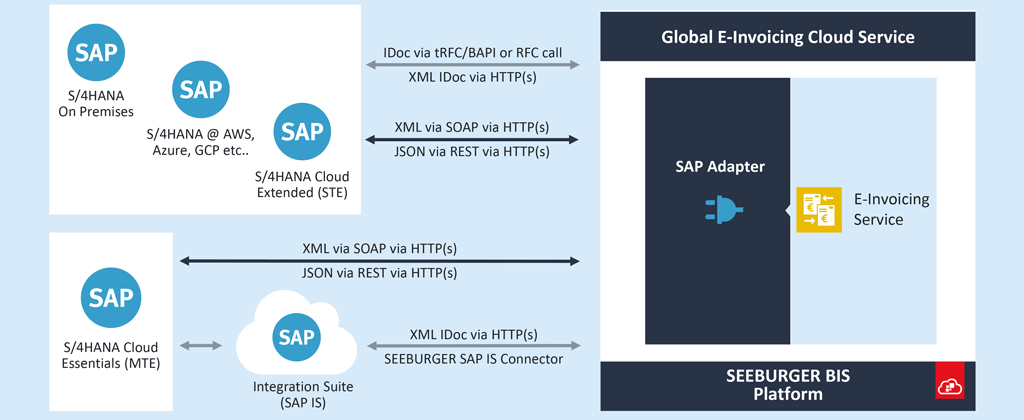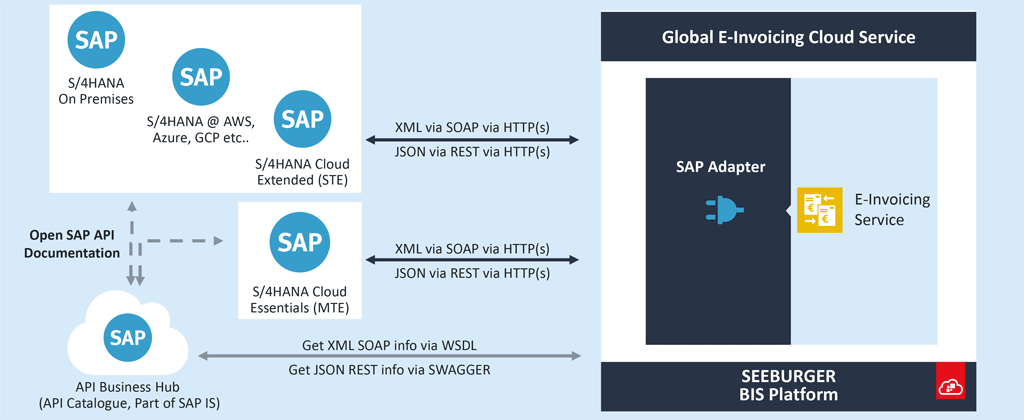
As SAP will be withdrawing support for Business Suite 7 software in 2027, including SAP ECC (ERP Central Component), many businesses are evaluating the scenario of migrating to S/4HANA – either with a greenfield or brownfield approach. The act of migrating to S/4HANA is complex and costly, often stretches over years, and will be not the only major challenge facing businesses. For example, what is going to happen to e-invoicing during the changeover?
Introduce SAP S/4HANA and innovate with e-Invoicing
While migrating to SAP S/4HANA, your existing e-invoicing needs will still need to be reliably met.
Furthermore, you can’t afford to stand still with e-invoicing. Compliance with Continuous Transaction Controls (CTC), as well as new e-invoicing and electronic VAT reporting stipulations, mean that you will need frequent updates. Continuing to comply with the above helps to avoid penalties for non-compliance, disrupted business processes and dissatisfied customers.
On the ERP side, any connections and integration between an ERP system and external applications still need to work, ensuring flexibility and protecting the investment in your current and future ERP and application landscape. This is also important for hybrid ERP landscapes, which contain non-SAP ERPs and accounting systems in local offices.
How can you easily connect SAP ECC and SAP S/4HANA and e-Invoicing?
ECC certified integration for SAP can be done through various interfaces, such as:
- tRFC or file-based IDoc transport
- RFC interface
- BAPIs – Allows you to receive RFC calls sent by SAP and sends back responses created by BIS
- API WebServices
For SAP S/4HANA, we differentiate between Classic Integration and API Integration. With SEEBURGER’s e-invoicing cloud services, you have full flexibility to choose the best type of connection for your needs.
Classic Integration of SAP S/4HANA with Global e-Invoicing Cloud Service
In the classic integration scenario for SAP S/4HANA, it is crucial to differentiate between the operating types which vary by deployment location:
- On-premises
- SAP private cloud
- SAP public cloud
SAP S/4HANA environments on-premises or in the SAP private cloud
- The classic integration of SAP S/4HANA is of the same type used currently for SAP ECC systems, where IDocs are transmitted via a tRFC connection.
- SAP S/4HANA environments on-premises or in the private cloud still support classic integration.
- Since IDocs are well established and easily available, they will most likely also be used on the SAP S/4HANA systems.
SAP S/4HANA environments in the SAP public cloud
- SAP S/4HANA in the public cloud requires integration into the SEEBURGER BIS by using the SAP Integration Suite (formerly known as SAP CPI) to forward the invoices.
 Figure 1: Classic Integration of SAP S/4HANA using the global e-invoicing cloud service
Figure 1: Classic Integration of SAP S/4HANA using the global e-invoicing cloud serviceAPI Integration of SAP S/4HANA with Global e-Invoicing Cloud Service
Regardless of the operating type outlined above, APIs are becoming an alternative to IDocs. They are often, for example, used to post invoices or purchase orders received by EDI systems:
- SAP APIs are available for processing B2B documents e.g. customer and supplier invoices
- The BIS API Gateway already supports these interfaces
- API descriptions from the SAP API Business Hub can be imported into BIS
- BPEL processes can be implemented using the SAP APIs
 Figure 2: API Integration of SAP S/4HANA with Global E-Invoicing Cloud Service
Figure 2: API Integration of SAP S/4HANA with Global E-Invoicing Cloud ServiceUse API or tRFC for connecting SAP S/4HANA to Global e-Invoicing
SEEBURGER sees that many use cases today can either be enabled, or would benefit from real-time, synchronous API usage, and we provide the flexibility and solutions to do this.
However, ERP invoicing processes are traditionally batch-driven processes. These will not derive any significant benefit from immediately being migrated from tRFC to API. So why not wait until you have a good business case for migrating your ERP invoicing? While migrating to SAP S/4HANA, you have other more urgent fish to fry.
Therefore, we recommend first switching to API for e-invoicing once it is properly supported by SAP S/4HANA.
Benefits of SAP S/4HANA and SEEBURGER e-Invoicing
Decades of experience working closely with SAP
- SEEBURGER solutions have been SAP-certified since 1995 – from classic EDI certification to the technically demanding NetWeaver PO certification.
- To date, SEEBURGER has received more than 50 individual certifications.
- As one of the few exclusive partners whose products are distributed worldwide by SAP, SEEBURGER has also received the highest product quality seal as part of the premium qualification.
Seamless SAP integration
- Connect any SAP system or even heterogeneous system landscapes to SEEBURGER solutions
- Avoid a massive SAP implementation project or extensive BADI programming by using SEEBURGER instead
- Reduce costs
SEEBURGER Solution Extensions for SAP
- Simplify the processing steps in SAP S/4HANA, all the way through the process.
- Use end-to-end processes from SAP with SEEBURGER Solution Extensions in SAP, such as SEEBURGER Purchase-to-Pay, SEEBURGER OmniChannel-to-Cash, SEEBURGER Console or the SEEBURGER API Monitor
Experience in e-Invoicing & CTCs
- Benefit from our experience in several hundred projects in electronic VAT reporting to tax agencies in countries including France, Germany, Hungary, India Italy, Spain, and Mexico.
- This includes experience in the standards and legislation required in each country.
- Avoid a hotch potch solution by using one platform for your e-invoicing needs worldwide.
- Cost-efficient
All-in-one single e-Invoicing platform
- A modular approach, which enables you to comply with global and specific local legislation by adding the modules you need.
- Highly flexible, adaptable and scalable
- Includes support for non-SAP, local GSPs, digital signatures and archiving.
- Runs on-premises, in the cloud or in a hybrid mix of both operating types
Summary for SAP S/4HANA Integration with Global e-Invoicing
The need to migrate to SAP S/4HANA within the next couple of years will be a massive project. Regardless of whether one takes the green or the brown pill, it is worth considering what you can remove from the core project to make the whole venture easier to handle.
At the same time, we are observing an increase in mandatory e-invoicing for B2B and tax reporting in Europe and elsewhere.
The SEEBURGER BIS E-Invoicing Solution includes controls for the processing of incoming and outgoing invoices, as well as extensions for deep process integration into any SAP ERP system. This includes the seamless integration of SAP S/4HANA, either directly or via the SAP API Business Hub, making your SAP S/4HANA migration easier as you only need to switch from your legacy ERP system once you are ready.
We are an experienced provider of cloud services, offering a single-source solution to enable you to comply with global and specific local legislation, both within Europe and further afield. If you use SAP’s eDocument Cockpit on S/4HANA, this can also be integrated into our Global E-Invoicing Services. See the blog on Global Invoicing with SAP S/4HANA and the eDocument Cockpit for details.
Find more Information
- Global e-Invoicing Regulations
- Migrate to SAP S/4HANA keeping B2B/EDI Integration running
- SAP S/4HANA Integration
Source: https://blog.seeburger.com/how-to-use-sap-s-4hana-with-apis-for-global-e-invoicing/
 expertise
expertise
